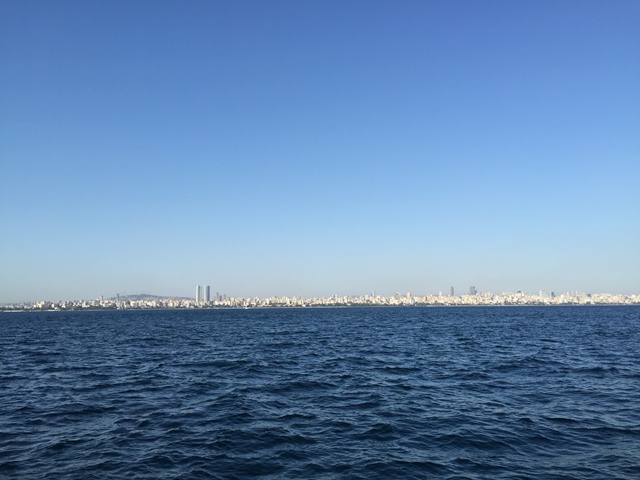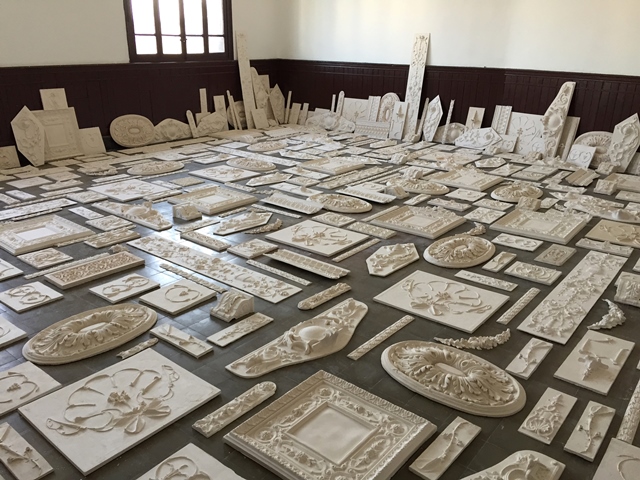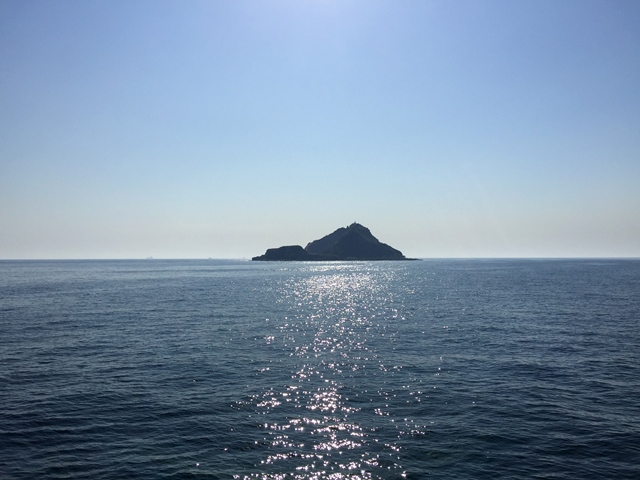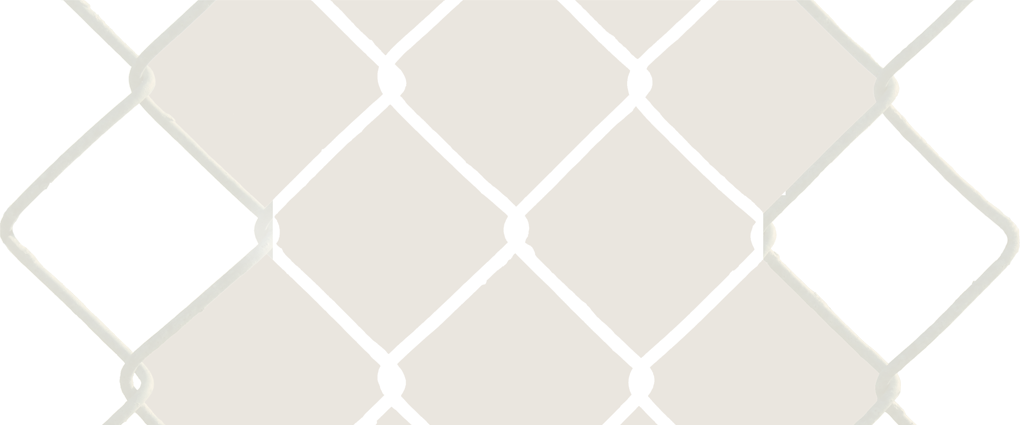In Istanbul: once you start digging, so much stuff comes out that there's nowhere to put it, and, eventually, you just bury it back in the ground.1
- Elif Batuman
In Istanbul (fig. 1) it is difficult to do anything without literally running into the past. Here, the past is not just a reminder of a time before, but a tangible and physical substance. The past is an object with a force that stops development in its tracks and slows the incessant pace of capitalism to a crawl: train tunnels are halted by thousand-year-old ships, buried churches impede highways, and bridges are stalled by deeply buried Neolithic graveyards. Even something as intangible as Istanbul’s ancient skyline can flatten skyscrapers when it is judged they damage the panorama of its historic old town, a world heritage site.
In Istanbul, the past is surplus, and like many things in overabundance, it can become a nuisance. Turkey’s current president, Recep Tayyip Erdoğan’s has described archeological artifacts as “obstacles in our path.” Questioning the importance of these objects, and subsequently, the past to Istanbul’s current accelerated state of development, Erdoğan has asked, “are these things really more important than the human?”2
Since the foundation of the Republic, to further anchor Turkish identity, officials have sometimes rewritten the past to support the dominance of Turkish culture. The founder of modern Turkey, Mustafa Kamal Atatürk (1881-1938), began by promoting a history that redefined Turks and their historic homeland in Central Asia as the cradle of civilization. He described a past where pre-historic Turks built a magnificent civilization in Central Asia, but were dispersed to different parts of the world, becoming Sumerians who developed the first alphabet or Egyptians who built the pyramids, before returning to the Ottoman Empire.3 Atatürk even went as far as supporting a nationalist theory of language, The Sun Language Theory, which claimed that all human languages descended from one early Turkic, primal language.4
In current Turkey, history has continued to be wielded as a political tool, but, unlike in Atatürk’s time, for the gains of a few rather than the entirety of the country. As is becoming clear to some Turkish citizens, current politicians use historically progressive language, the rhetoric of progress that Turkish Republican leaders employed during the founding of the republic, to argue the need for rampant overdevelopment, which is having profound ecological and economic consequences; essentially destroying the country’s natural resources, poisoning the environment, increasing pollution and depleting its economy for the future.5
Atatürk practiced a rhetoric of progress during his presidency between 1923-38, when the Republic was new, poor and very underdeveloped. As Turkey entered into European politics, he aimed to counter the then popular sentiment amongst Europeans to disparage Turks and other non-Western peoples. His development projects received popular support in order to modernize Turkey like the European nations. Presently, Turkey is a G20 country, no longer poor, yet state leaders still prey upon the public's insecurities that they are falling behind, and therefore must increase development, despite the fact that similar ventures in other countries have historically failed. There is a price to pay for overdevelopment and environmental degradation, suggesting history is being employed for the benefit of the few and the momentary, and will eventually bring the country to the brink of collapse.
figure 1
|
 |
Istanbul's skyline from the bosphorus |
This year’s 14th Istanbul Biennial, Saltwater: A Theory of Thought Forms, curated by Carolyn Christov-Bakargiev6, aims to look outside the human present: to the environment, animals, the universe, forces, waves and flows.7 Yet the most dominant presence in this exhibition is the past, bearing down on the present. It becomes a subject, an aesthetic and the stage set. This is not the nostalgic or glorified past, but one of breakdown, strife and disregard, a past that ignored the future and is lost within it.
Numerous artworks are placed within aged or abandoned buildings: grey, driftwood-like floors and furniture, and broken plaster walls, giving stark contrast to neon contemporary art. Shops, factories and parking garages are emptied of machines, allowing ample space for sound installations (fig. 2) and film soundtracks to reverberate in concrete voids. Schools without classes and students are used as exhibition sites where school desks and chalkboards are assimilated into sculptures, becoming formal reminders of the absence of bodies and the latent possibilities of education.
figure 2 |
 |
Cevdet Erek
Bir Ritim Mekâni - Otopark (A Room of Rhythms - Otopark), 2015
14thIstanbul Biennial
Istanbul, Turkey |
There are also artworks that represent a form of reverence for a somewhat more distant metaphysical, mystical or wondrous past, such as a sympathetic display of photographs of the Aurora Borealis by the early twentieth century Norwegian physicist Fredrik Carl Mülertz Størmer (fig. 3) (1874-1957), the nebulous Thought-Forms (1905) drawings by the theosophist Annie Besant (1847–1933), and beautiful pen on paper drawings of neural networks by the Spanish neuroscientist Santiago Ramon y Cajal (1852-1934).
figure 3 |

|
Carl Størmer photographing the Aurora Borealis with an assistant, Birkeland, Norway 1910 |
Yet it is history overlooked, buried and contested that becomes the most affecting and lasting aspect of the Biennial. A portion of the biennial is presented on Büyükada, a resort island off the coast of Istanbul. On the island, artworks are displayed within the decay of several seemingly abandoned mansions. Later, I learn many of these buildings were built and owned by wealthy Greeks, Jews and Armenian Turkish, who left during periods of violence against non-Turks before and after the modernization period. The buildings are left abandoned because they are difficult to sell when the original owners cannot be located. Furniture, tools and dust are all that remain from their former inhabitants.
Several installations in the Biennial allude to the buried history of genocide, mainly the Armenian (1915), which Turkish authorities and many of its people do not fully acknowledge8. The Turkish artist Aslı Çavuşoğlu presents Red/Red paintings on paper made with a pink dye, extracted from Armenian cochineals, a scale insect indigenous to the Ararat plain and Aras River valley in the Armenian Highlands, which is used to make a dye called vordan karmir or “worm’s red”. The species is critically endangered in Armenia due to human overdevelopment – one organism pushed out by a dominant other. Francis Alÿs exhibits the film, The Silence of Ani (Ani’nin Sessizligi), 2015, where youth perform a symphony of bird songs within the ruins of the medieval Armenian city of Ani.
And almost hidden are two drawings by Arshile Gorky (1904–1948), Act of Creation (Yaratma Eylemi), 1947 and Vale of the Armenians (Ermenilerin Diyari), 1944, raging on the top floor of Orhan Pamuk’s Museum of Innocence. Gorky was an ethnic Armenian born in Turkey who later fled during the Armenian Genocide, losing his mother in the process. Eventually, he landed in the United States, where he took up art and became a key figure in early Abstract Expressionism.
figure 4 |
 |
Michael Rakowitz
The Flesh is Yours, The Bones Are Ours, 2015
Galeta Greek Primary School
14th Istanbul Biennial, Istanbul, Turkey |
In a comprehensive art installation, which mirrors the formal appearance of an archeological dig mixed with an unfinished natural history display, Michael Rakowitz tells a history of Armenian architects in Turkey employed during the time of the Ottoman Empire (fig. 4). Through plaster castings, remains, documents and photographs presented within neatly narrated display cabinets, he recounts the profusion of the architect’s labors, responsible for hundreds of buildings and thousands of plaster decorative building elements visible throughout Turkey, before their practice ceased during the ethnic massacres and expulsions of WWI. He also tells a story of historical redefinition around one of Turkey’s most famous architects, Mimar Sinan (1489/1490 – July 17, 1588). Sinan was the chief architect for Sultans Suleiman the Magnificent, Selim II and Murad III during the early Ottoman Empire. He designed over 300 buildings throughout Turkey and beyond. And although it is certain his ethnic heritage is Armenian, even now he is still considered by many Turks to be Turkish.9 One wonders if the urge to continue to claim Sinan as Turkish follows in Atatürk’s aims to nationalize all cultural production, and that to debate it or admit he was Armenian would dislodge other more grievous historical errors.
figure 5 |
 |
Sivriada Island near Istanbul, Turkey |
Rakowitz’s project also includes dog bones excavated from the island of Sivriada (fig. 5) in the Marmara Sea, where a half mile off its coast a flamboyantly inaccessible underwater sculpture by Pierre Huyghe was also located, although it is under construction for the unforeseen future. The dog bones are the remains from some 80,000 Istanbul street dogs, which were rounded up and sent to the deserted island in 1911. Because the dogs expulsion was argued in nationalist rhetoric, for some this event is considered the precursor to the Armenian Genocide of 1915. Any dog without an owner was not considered a Turkish citizen and therefore banished to the island. Most dogs died of starvation, though some drowned trying to swim back to the city. People said for days on the mainland they could hear the dogs howling. In 1912 when an earthquake struck and destroyed much of the city, many claimed that god was angry at their treatment of the dogs.10
On the opening day of the Biennial I witness a somewhat aimless public discussion between Turkish artist Füsun Onur, Carolyn Christov-Bakargiev and curator Hans-Ulrich Obrist. When Onur describes moments of frustration when she was compelled to dump her sculptures into the Bosphorus as an act of catharsis, Christov-Bakargiev suggests that Onur’s act of sacrificing her excess art, is like the French philosopher Georges Bataille’s idea of the Accursed Share (Les Éditions de Minuit, 1949). For Bataille, the Accursed Share represented excess energy that cannot be absorbed into any system of production. Energy, he says, eventually, must be spent, willingly or not, gloriously or in an act of catastrophic explosion.11 In any unregulated system, climate change for example, where the burning of so much fossil fuel produces an excess of energy, energy accumulates and eventually must be released, causing adverse results. Christov-Bakargiev was suggesting that Onur’s frustration was perhaps prompted by a build up of her energy, and the dumping of sculptures was her way of releasing the excess, avoiding a breakdown.
Beyond Onur, the specter of the Accursed Share – was palpable everywhere, in the Biennial and in the temperament of the city itself. There was a feeling that so much energy had been put into development, construction and the maintenance of a certain history, of a dominant national identity, that it was reaching a breaking point. The biennial advertised fluid and flowing motifs of waves and currents, and was described as an experience that takes place often on salt water, slowing down the audience and healing the body. Yet all around me, from the people on the streets to the artworks, this was not the feeling present. What felt most urgent was a swelling and a flood, a shaking, tense energy, that here Istanbul stood on the edge, at the brink, waiting for the spark that will ignite an explosion.

1 Batuman, Elif. "The Big Dig: Istanbul’s City Planners Have a Problem: Too Much History". The New Yorker. New York: August 31, 2015. http://www.newyorker.com/magazine/2015/08/31/the-big-dig
2 Ibid.
3 Akyol, Mustafa. "From Atatürk to Erdogan: Turks rewrite history". Turkey Pulse, Al-Monitor. Washington, DC: 20 November 2014. http://www.al-monitor.com/pulse/originals/2014/11/turkey-historical-revisionism-ataturk-erdogan.html#ixzz3lk9jbDAG
4 “Turks Teach New Theories”. The New York Times. 9 February 1936. http://www.azargoshnasp.net/recent_history/
pan_turkist_philosophy/turksteachnewtheories.htm
5 The following perspective is provided by the Turkish art historian and curator Berin Golonu from an email conversation on 15 September 2015, on the current state of Turkish Politics and how Turkish politicians are using history for political gains.
6 I am using the word curator for clarity although Carolyn Christov-Bakargiev does not actually refer to herself as the curator of this biennial, but instead uses the term ‘drafter’of the Biennial.
7 This biennial is similar in character to Carolyn Christov-Bakargiev’s last major curatorial project dOCUMENTA (13), which equally emphasized the Non-Human. In the introduction to dOCUMENTA (13) on the welcome page of its website, it is described as “a holistic and non-logocentric vision that is skeptical of the persisting belief in economic growth, a vision that is shared with, and recognizes, the shapes and practices of knowing all the animate and inanimate makers of the world, including people.” From http://d13.documenta.de/#welcome/
8 On 23 April 2014, some 99 years after the official anniversary of the Armenian Genocide, President Erdoğan, in a public statement, offered condolences to the grandchildren of Armenians who lost their lives in 1915. This was the first time a Turkish leader has formally offered condolences for the mass killings. However, Erdoğan would not describe the event as a genocide, and went on to generalize by stating that “millions of people of all religions and ethnicities lost their lives in the First World War". Turkey has never fully admitted to what Armenians, most scholars and several nations have described as the Armenian Genocide. "Turkey offers condolences to Armenia over WWI killings". BBC. 23 April 2014. http://www.bbc.com/news/world-europe-27131543
9 This symbolic repatriation began in 1935, during Atatürk’s presidency, when Turkish authorities exhumed Sinan’s body to measure his skull in an attempt to prove his Turkish ancestry. Vercihan Ziflioğlu, “Peerless Turkish Architect Claimed to be Headless in Tomb”, Hürriyet Daily News. Istanbul: 9 July 2010. http://www.hurriyetdailynews.com/default.aspx?pageid=438&n=-2010-07-09
10 Michael Rakowitz told me he could find no record of this earthquake, and believes it is more a myth than reality. Although I believe the Mürefte earthquake of 1912 was the event the stories refer to. However it did not hit Istanbul directly, but rather at the base of the Gallipoli Peninsula, 200 miles from Istanbul. 2,800 inhabitants were killed, 7,000 inhabitants were wounded and 12,600 houses were destroyed. http://www.ngdc.noaa.gov/nndc/struts/results?
eq_0=2955&t=101650&s=13&d=22,26,13,12&nd=display
11 Bataille, Georges. The Accursed Share: An Essay on the General Economy. Volume 1: Consumption. New York: Zone Books. 1988: p. 21
|











